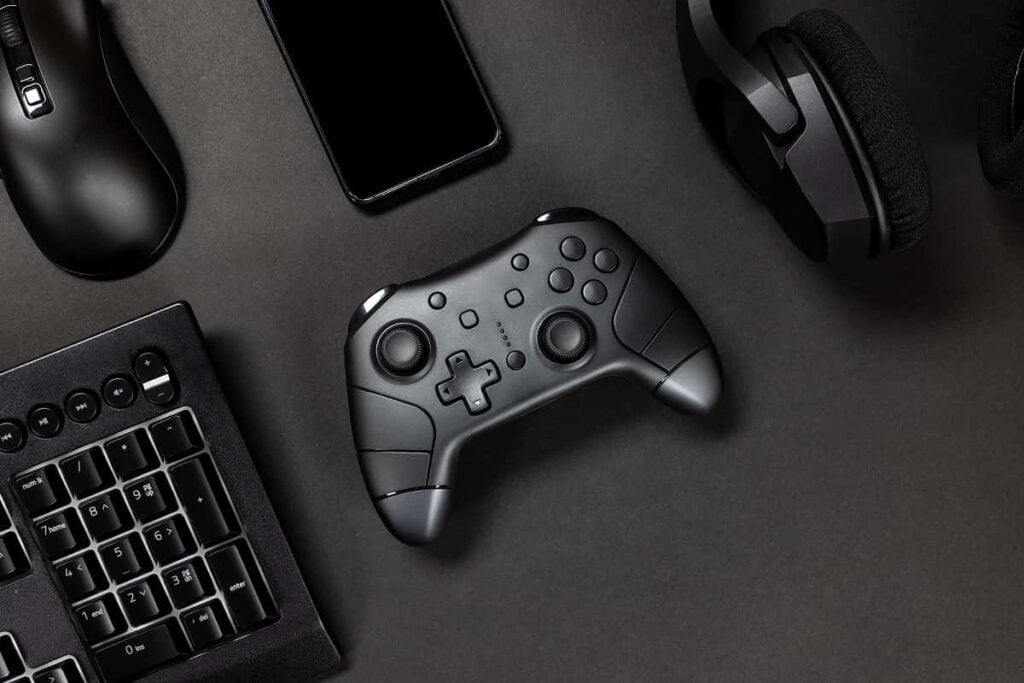Unity to Acquire ironSource: Good News or Bad?
Table of contents

The epitome of a first-world problem is complaining that the supercomputer that’s constantly by your side – the one mostly used to read inane drivel on social media or play games – doesn’t stay charged long enough. All that cheap constantly available electricity available everywhere doesn’t stay in that incredibly engineered compact lithium battery long enough so that you can maximize the amount of time you spend adding zero value to society. When the metaverse finally gets here, the problem will only get worse.
Social media and mobile games may not add much value to society, but they’re a great distraction from all the highly advanced automation technologies that are stealing everyone’s jobs. The average adult in America spends 4.3 hours a day on their mobile phone, and it’s not just a first-world luxury. There are over 6.7 billion app-enabled devices globally, and 83% of the time spent on them is in apps.
Mobile gaming is now a $76 billion industry and one that Unity Software (U) dominates. In the fourth quarter of 2020, 71% of the top 1,000 mobile games were made with Unity with 94 of the 100 game development studios by global revenue in 2020 being Unity customers. Today, Unity took a major step towards becoming even more entrenched in the mobile arena. They acquired ironSource (IS), a company whose platform powers 87 of the top 100 mobile games.
Although everyone likes to compare us to AppLovin and Unity, our vision is to build the most comprehensive business platform we can for games and a central distribution channel for app developers, including on-device inventory.
Omer Kaplan, CRO and co-founder of ironSource via AdExchanger
Unity Acquires ironSource
Every investor has access to the same information, yet we all respond to it differently.

You know what makes us throw up our hands in despair? Clickbait titles like that. Today, Unity Software traded down 17% on the news that they’ll be acquiring an Israeli firm called ironSource which went public using a special purpose acquisition company (SPAC) just over a year ago. That was at a valuation of $11 billion, and today they’re being acquired for consideration of $4.4 billion. Let’s start with the terms:
Each ordinary share of ironSource will be exchanged for 0.1089 shares of Unity common stock. Once closed, current Unity stockholders will own approximately 73.5% and current ironSource shareholders will own approximately 26.5% of the combined company.
Unity Software
What’s interesting about these terms is that it shouldn’t matter what happens to either share price. If we assume there’s a 100% likelihood the deal closes in Q4-2022, then the value before the deal was announced shouldn’t be much different from after. Indeed, the combined value of these two companies changed from $14 billion to $13.1 billion on news of the merger – a drop of $900 million or about 7%. Here’s a look at the combined market caps of Unity and ironSource before and after the merger compared to post-merger ownership.

The drop in Unity share could relate to the company using this as an opportune time to fine-tune their guidance – yet again – which represents a low single-digit adjustment. We’re not overly concerned about that right now. Instead, we’d like to see what the newly formed entity looks like while keeping things as simple as possible. We already researched Unity Software’s business model extensively, and looked at why their shares took a dump last quarter, so let’s take a closer look at a firm we’ve never covered before – ironSource.
About ironSource

Founded in 2011, ironSource provides a platform that a) helps mobile gaming app developers of all sizes monetize their hard work, and b) helps mobile network carriers “optimize device experiences.” Here’s a diagram which is about the extent to which we’ll explain their offering.

Revenue breakdown between these segments is Sonic (87.5%) and Aura (12.5%). It’s great to see this breakdown in the financials along with a handy chart showing geographical exposure based on where they send invoices.

ironSource touches nearly 29% of the world’s population every month across all the apps they power. That’s more than the population of Europe, the United States, and the great country of Africa combined. What’s more interesting is how they make money.
A substantial majority of our revenue is currently generated under a revenue-share model with our customers, whereby we take a percentage of revenue earned by them for serving in-app advertising placements in their apps and games, or through on-device placements.
Credit: ironSource
This means we need to consider “net retention rate” in an entirely different context. The amount of extra spend from existing customers depends on how much ad spend their apps generate. ironSource customers need to continue developing compelling apps that people want to play else net retention rate will fall. So far, that’s not been a problem.

We’re also given gross retention rate, 98% in 2021, which means only 2% of their customer base stopped paying them money. When we say, “customer base,” we’re referring to the 397 customers who pay them more than $100,000 in revenue, and who collectively accounted for 94% of total revenues in Q1-2022. (No single customer accounted for more than 10% of revenues.)

The 10-K tells us that 18% of their 358 customers in Q4-2021 were non-gaming, and they’re planning to expand their offering into other industry verticals. The buzzword-laden merger deck served up by both companies to describe “Project Aroma” seems mostly catered to an internal audience as do some of the Q&As made in the regulatory filings – like layoffs.
Layoffs and More Layoffs
We noticed some armchair Twitter CEOs complaining about layoffs at Unity happening concurrently alongside the acquisition, so we’ll explain how this works. We’re in a bear market which means companies start to tighten purse strings. It’s an excellent time to kick the bottom 10% to the curb, the people who would rather engage in activism than do solid work, for example. (Seems like this is happening a lot in tech companies lately.) Rock stars don’t engage in activism because they’re busy being rock stars. They know their jobs are safe, and they also know who is getting shown the door because underperformers stand out like sore thumbs in high-performing teams.
It’s good to get some layoffs out of the way before the acquisition closes because the $300 million in synergies isn’t going to materialize without some heads rolling. As shareholders in Unity, we appreciate the housekeeping taking place and hope that aggressive steps will be taken to realize synergies post acquisition. While McKinsey’s research on M&A is a bit dated, the lessons are timeless – most M&A events fail to realize the expected level of synergies. It’s just like dating. Everyone puts their best foot forward until the commitment happens, then the truth rears its ugly head.
Some Parting Thoughts
This is the last time we’ll get to ironSource before they become one with Unity Software. Regarding the purchase price, Unity says they handed over $4.4 billion worth of shares (more on this in a second) which ascribes a simple valuation ratio of 6 to ironSource. Not half bad, considering Unity’s own simple valuation ratio sits at 9 right now. But perhaps it’s easier to visualize the exchange of value by walking through the actual transaction as follows:
- Each ordinary share of ironSource will be exchanged for 0.1089 shares of Unity common stock
- ironSource had 1,018,468,804 shares outstanding in their last annual report
- ironSource receives 110,911,252 shares of Unity
- 110,911,252 * 7/12/2021 closing price of $39.76 = 4,409,831,379. That’s the $4.4 billion Unity is referring to.
- Unity has 279,170,161 shares outstanding
- When the merger completes, Unity shareholders will own 72% of the pie while ironSource shareholders will own 28% of the pie
This rough calculation isn’t far off from what Unity tells us.
Once closed, current Unity stockholders will own approximately 73.5% and current ironSource shareholders will own approximately 26.5% of the combined company.
Unity Software
The merger is expected to close during Unity’s 4th quarter of 2022 and the Unity Board has approved up to $2.5 billion in share buybacks over the next 24 months to help offset dilution (great to see a company buying shares back when they’re beaten down). The two largest Unity shareholders, Silver Lake and Sequoia, are investing another $1 billion in Unity in the form of a convertible note with a conversion price of $48.89 per share in 2027. This means that both investors believe that shares will trade meaningfully above that price so they can capture more upside than the 2% interest rate they’re charging Unity.
Our concern with any SaaS business is always durability. How easily can the software service be eliminated or substituted? In the case of ironSource, they’re only as successful as their customer’s apps. This is where we’ll revert to a statement made by Unity in reference to their industry’s resilience in times of economic turmoil.
Through virtually every major crisis, the game industry has grown. Through recession, the game industry has grown. Through catastrophes like 9/11, the game industry had strong weeks immediately following. It is what people do when they’re frustrated.
Unity Software
ironSource touches 2.7 billion active users across this planet. What’s the likelihood the tuk-tuk driver in Dhaka who has been waiting for petrol now for over 48 hours will suddenly stop playing mobile games? He may not be some big whale spending thousands every week on in-game purchases, but he’s a potential customer for any number of Bangladeshi consumer brands. ironSource commands a population of 2.3 billion people that Unity app developers can access intelligently using contextual data which sidesteps all those privacy concerns. We see this merger as a positive event based on the ironSource metrics presented today and may use this as an opportunity to add shares.
Conclusion
Let’s hope the merger goes through as planned because it seems like this event will help Unity reach the goal they stated in the last earnings call – “we believe we will achieve profitability in the fourth quarter of this year, which is sooner than previously communicated.” We’re trusting that the bright minds at Sequoia and Silver Lake that vetted this merger plan thought it through sufficiently as a way for Unity shareholders to receive more value in the long run. If we decide to add some shares of Unity, Nanalyze Premium annual subscribers will receive a trading alert.
Sign up to our newsletter to get more of our great research delivered straight to your inbox!
Nanalyze Weekly includes useful insights written by our team of underpaid MBAs, research on new disruptive technology stocks flying under the radar, and summaries of our recent research. Always 100% free.
















Based on their closing prices on July 12th, the deal had implied price per share for ironSource of $4.33.
ironSource price as today is $3.335.
Obviously Unity price dropped on the news, so the effective buy price per share for ironSource is lower: $3.57.
Still that means upside of 7% based on today’s ironSource price.
So if you want to buy Unity now: maybe it is better to buy ironSource instead, which will give you Unity at 7% discount.
We were sort of assuming the deal would go through in our analysis which isn’t a given. That uncertainty is also baked into the stock prices by hedge funds that focus on M&A arbitrage.